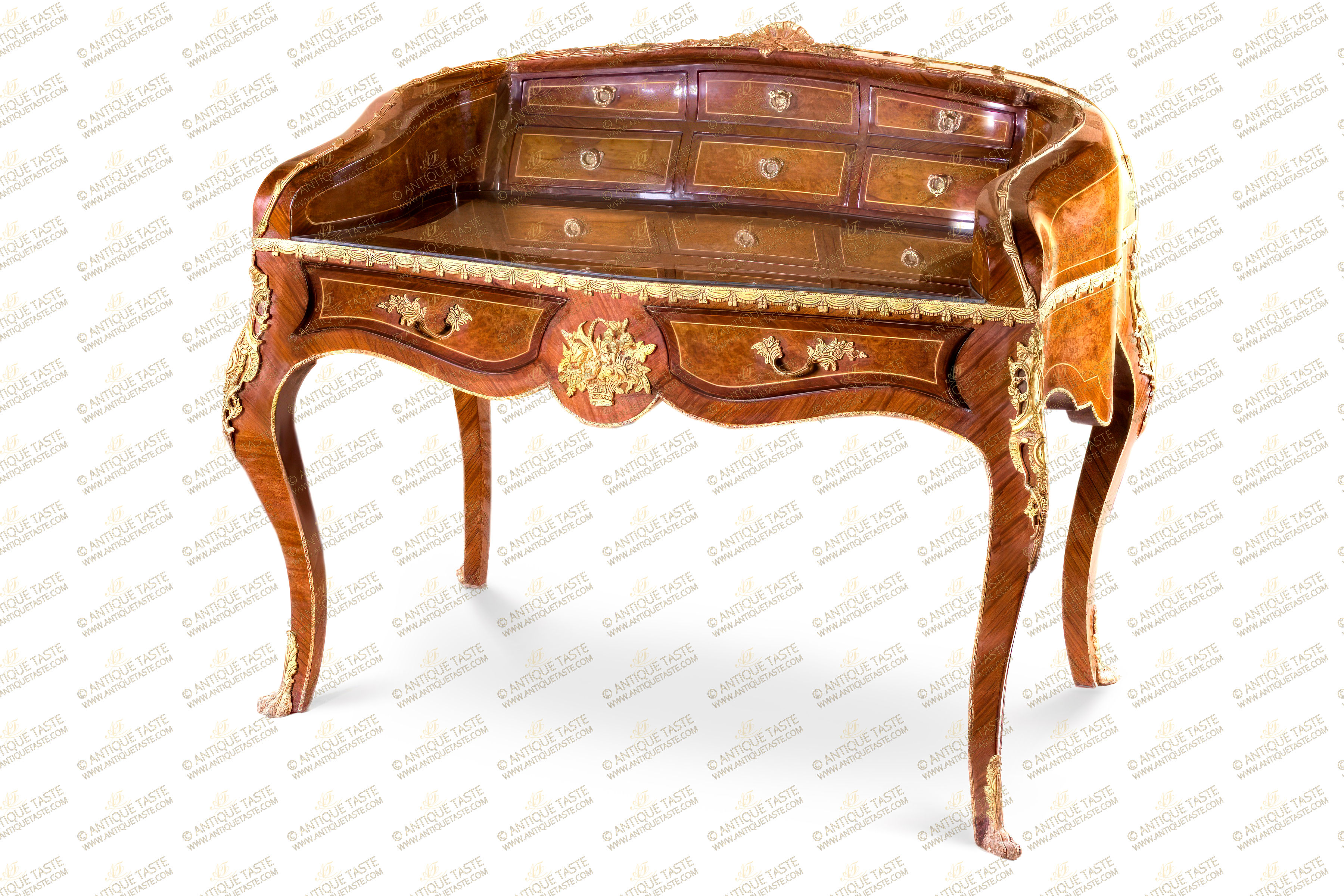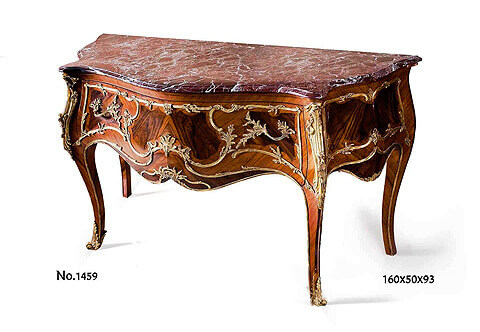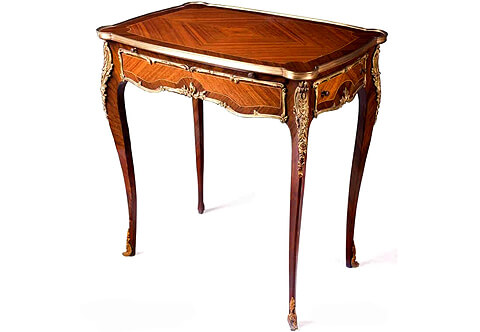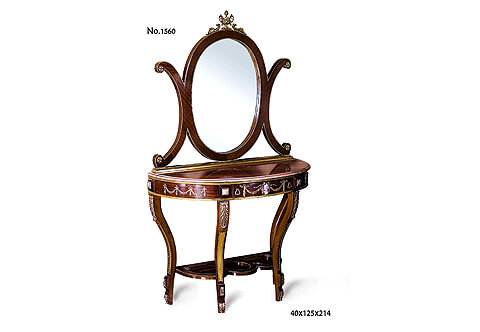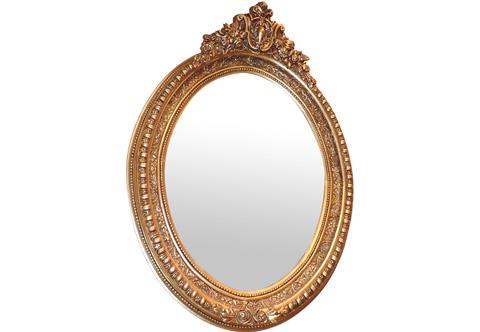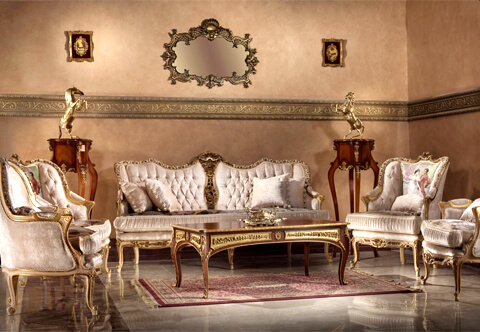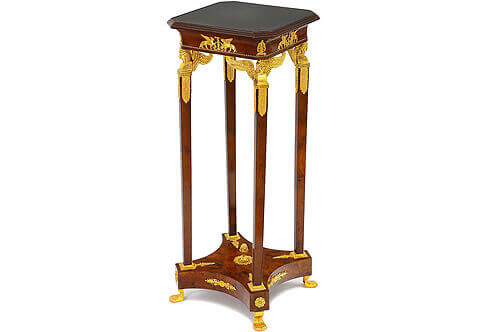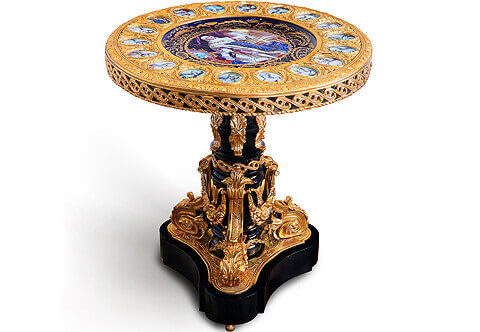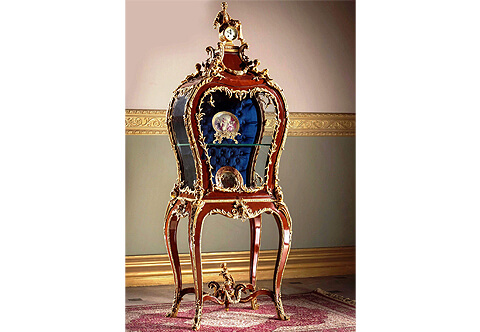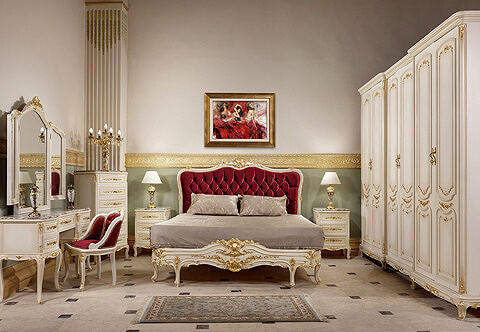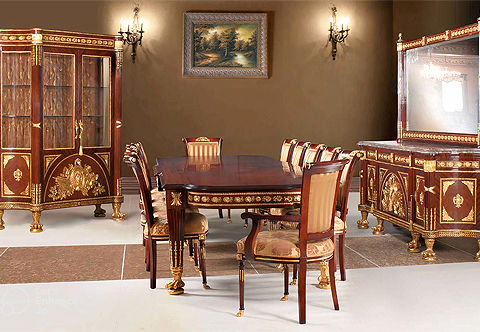French Louis XV Rococo style semi-kidney-shaped ormolu-mounted and double veneer inlaid Ladies writing Secretary Desk / Bureau De Dame after the model by François Linke
Ref#D-244 | Description
A sophisticated French Louis XV Rococo style semi-kidney convex-shaped ormolu-mounted and double sans-traverse veneer inlaid Bureau De Dame / Ladies writing Secretary Desk the model by François Linke;
The serpentine convex upper structure is surmounted with a fabulous ormolu shell issuing a fine detailed foliate ormolu filet in a satin and burnish finish extends on each curved side;
The interior is fitted by six various size drawers with ormolu ring handles, the gilt-tooled inset leather writing surface above a fabulous drape-shaped wrap-around ormolu band;
The scalloped frieze centered with a remarkable ormolu flower bouquet basket flanked by two shaped drawers with foliate ormolu handles;
The desk is raised on bold cabriole legs decorated on top by large richly chased foliate and shell ormolu pierced chutes and terminated with ormolu hairy paw feet sabots, with delicate hammered ormolu filet running along the internal sides of the legs and all the lower contour of the desk.
Ref#D-244
H:118 x W:123 x D:70cm
Louis XV Rococo Style | François Linke
François Linke
Francois Linke (1855-1946) was arguably the leading Parisian cabinetmaker of the Belle Epoque the glittering age of fashionable French society, whose influence was felt throughout the world.
Determined to outshine the competition at the Exhibition, Linke had set about creating the most ambitious pieces he could envisage, and more extravagant than had ever been displayed before. The items he exhibited marked a transition from the historicist interpretation of Louis XV and Louis XVI styles, an interpretation that was the mainstay of his nearest rivals, to something startlingly new and vital in its immediacy. Together with Leon Message he developed a new style for the 1900 Exhibition that paid homage to the Louis XV rococo in the fluidity of its approach, but an approach fused with the lively flowing lines of the contemporary and progressive 'art nouveau'.
This risky endeavour was a resounding success, and with his reputation established, La Maison Linke became the pre-eminent furniture house until outset of the Second World War. The technical brilliance of his work and the artistic change that it represented was never to be repeated. His showrooms expanded into prestigious premises in Paris, in the Place Vendome as well as the Faubourg St. Antoine where his workshop had been established. He embarked on many important commissions in the years up to the outbreak of the First World War, making and designing furniture for leading international industrialists and bankers. After the 1914-1918 World War, Linke undertook the extraordinary commission to furnish the Ras al-Tin Palace in Alexandria for King Fuad of Egypt, possibly the largest single furniture commission ever conceived, eclipsing even Versailles. Linke flourished and remained active until the middle years of the 1930s and died in 1946.
The Rococo Style
The transitional phase in French furniture from Baroque to Rococo is called Régence. The heavy, monumental style of the earlier part of Louis’s reign was gradually replaced by a lighter and more fluent curvilinear style. The leading exponent of the Régence style was Charles Cressent, ébéniste (“cabinetmaker”) to the regent Philippe II, duc d’Orléans. In his work the ormolu (a brass imitation of gold) mounts, so important a part of the design of French furniture in the 18th century, became equal to if not more important than, the marquetry decoration of the carcass. The curvilinear form was introduced not only to externals, such as legs and supports, but, in the bombé (rounded sides and front) commodes that first appeared during this period, to the case itself. High-quality marquetry in coloured woods replaced ebony.
The Rococo style, a development of the Régence, affected French furniture design from about 1735 to 1765. The word is derived from rocailles, used to designate the artificial grottoes and fantastic arrangements of rocks in the garden of Versailles; the shell was one of the basic forms of Rococo ornament. The style was based on asymmetrical design, light and full of movement. The furniture of this period was designed on sinuous and complicated lines. Designs of Juste-Aurèle Meissonier, goldsmith to Louis XV, sculptor and architect, were instrumental in creating the Rococo. The repertory of ornament was large and included the C-scroll, scrolled foliage, floral motifs, ribbon, and, on occasion, trophies formed of musical instruments or gardening implements. The Rococo Chinese taste had conventions of its own: pagodas, exotic birds, Chinese figures, icicles, and dripping water. The graceful bombé commode, often with marble top and two or three drawers, the surface enriched with finely modelled ormolu mounts, was popular. Under Cressent’s influence the mounts predominated, though later in the century the marquetry decoration gained first importance. Commodes and other pieces were decorated with marquetry of floral or geometrical patterns, or sometimes with lacquer decoration, again combined with ormolu mounts. The most celebrated makers of mounts during Louis XV’s reign were Jacques Caffieri and his son Philippe. Jean-François Oeben was made ébéniste du roi (cabinetmaker to the king) in 1754; a pupil of Boulle, he was the most celebrated cabinetmaker of the period. [Joseph T. Butler]

